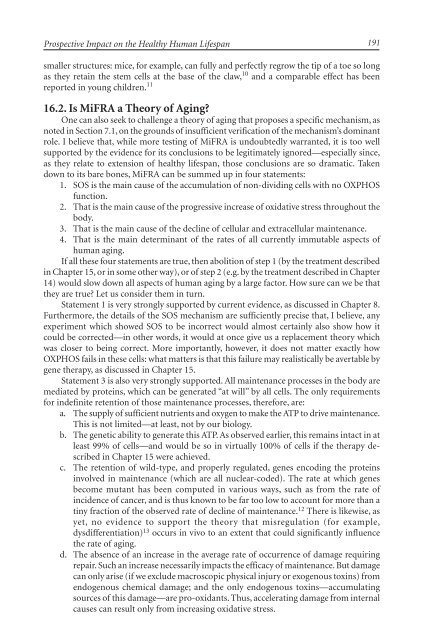The Mitochondrial Free Radical Theory of Aging - Supernova: Pliki
The Mitochondrial Free Radical Theory of Aging - Supernova: Pliki
The Mitochondrial Free Radical Theory of Aging - Supernova: Pliki
You also want an ePaper? Increase the reach of your titles
YUMPU automatically turns print PDFs into web optimized ePapers that Google loves.
Prospective Impact on the Healthy Human Lifespan<br />
smaller structures: mice, for example, can fully and perfectly regrow the tip <strong>of</strong> a toe so long<br />
as they retain the stem cells at the base <strong>of</strong> the claw, 10 and a comparable effect has been<br />
reported in young children. 11<br />
16.2. Is MiFRA a <strong>The</strong>ory <strong>of</strong> <strong>Aging</strong>?<br />
One can also seek to challenge a theory <strong>of</strong> aging that proposes a specific mechanism, as<br />
noted in Section 7.1, on the grounds <strong>of</strong> insufficient verification <strong>of</strong> the mechanism’s dominant<br />
role. I believe that, while more testing <strong>of</strong> MiFRA is undoubtedly warranted, it is too well<br />
supported by the evidence for its conclusions to be legitimately ignored—especially since,<br />
as they relate to extension <strong>of</strong> healthy lifespan, those conclusions are so dramatic. Taken<br />
down to its bare bones, MiFRA can be summed up in four statements:<br />
1. SOS is the main cause <strong>of</strong> the accumulation <strong>of</strong> non-dividing cells with no OXPHOS<br />
function.<br />
2. That is the main cause <strong>of</strong> the progressive increase <strong>of</strong> oxidative stress throughout the<br />
body.<br />
3. That is the main cause <strong>of</strong> the decline <strong>of</strong> cellular and extracellular maintenance.<br />
4. That is the main determinant <strong>of</strong> the rates <strong>of</strong> all currently immutable aspects <strong>of</strong><br />
human aging.<br />
If all these four statements are true, then abolition <strong>of</strong> step 1 (by the treatment described<br />
in Chapter 15, or in some other way), or <strong>of</strong> step 2 (e.g. by the treatment described in Chapter<br />
14) would slow down all aspects <strong>of</strong> human aging by a large factor. How sure can we be that<br />
they are true? Let us consider them in turn.<br />
Statement 1 is very strongly supported by current evidence, as discussed in Chapter 8.<br />
Furthermore, the details <strong>of</strong> the SOS mechanism are sufficiently precise that, I believe, any<br />
experiment which showed SOS to be incorrect would almost certainly also show how it<br />
could be corrected—in other words, it would at once give us a replacement theory which<br />
was closer to being correct. More importantly, however, it does not matter exactly how<br />
OXPHOS fails in these cells: what matters is that this failure may realistically be avertable by<br />
gene therapy, as discussed in Chapter 15.<br />
Statement 3 is also very strongly supported. All maintenance processes in the body are<br />
mediated by proteins, which can be generated “at will” by all cells. <strong>The</strong> only requirements<br />
for indefinite retention <strong>of</strong> those maintenance processes, therefore, are:<br />
a. <strong>The</strong> supply <strong>of</strong> sufficient nutrients and oxygen to make the ATP to drive maintenance.<br />
This is not limited—at least, not by our biology.<br />
b. <strong>The</strong> genetic ability to generate this ATP. As observed earlier, this remains intact in at<br />
least 99% <strong>of</strong> cells—and would be so in virtually 100% <strong>of</strong> cells if the therapy described<br />
in Chapter 15 were achieved.<br />
c. <strong>The</strong> retention <strong>of</strong> wild-type, and properly regulated, genes encoding the proteins<br />
involved in maintenance (which are all nuclear-coded). <strong>The</strong> rate at which genes<br />
become mutant has been computed in various ways, such as from the rate <strong>of</strong><br />
incidence <strong>of</strong> cancer, and is thus known to be far too low to account for more than a<br />
tiny fraction <strong>of</strong> the observed rate <strong>of</strong> decline <strong>of</strong> maintenance. 12 <strong>The</strong>re is likewise, as<br />
yet, no evidence to support the theory that misregulation (for example,<br />
dysdifferentiation) 13 occurs in vivo to an extent that could significantly influence<br />
the rate <strong>of</strong> aging.<br />
d. <strong>The</strong> absence <strong>of</strong> an increase in the average rate <strong>of</strong> occurrence <strong>of</strong> damage requiring<br />
repair. Such an increase necessarily impacts the efficacy <strong>of</strong> maintenance. But damage<br />
can only arise (if we exclude macroscopic physical injury or exogenous toxins) from<br />
endogenous chemical damage; and the only endogenous toxins—accumulating<br />
sources <strong>of</strong> this damage—are pro-oxidants. Thus, accelerating damage from internal<br />
causes can result only from increasing oxidative stress.<br />
191


